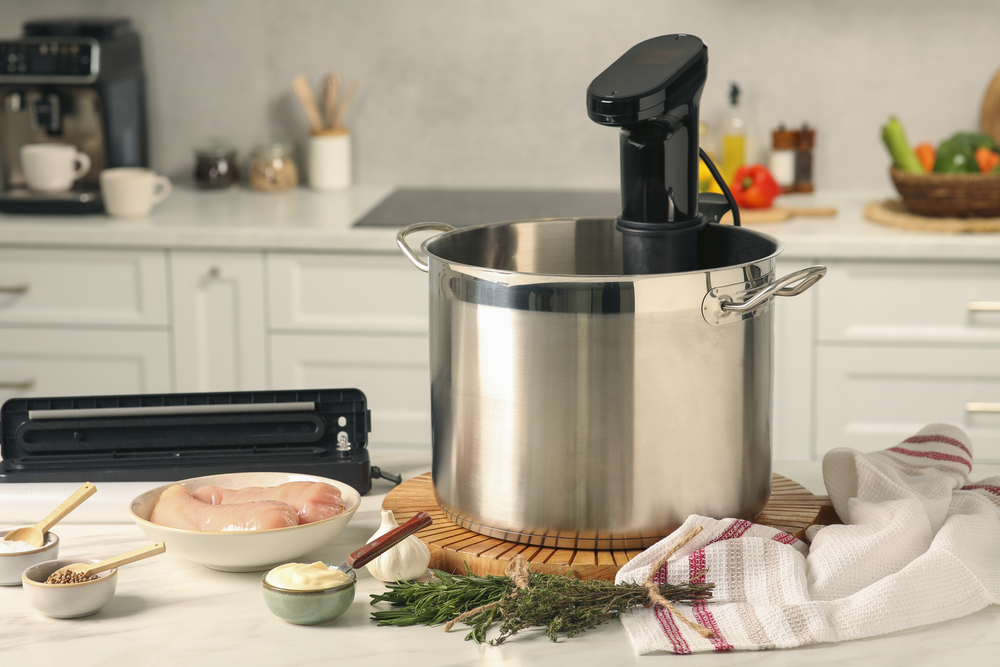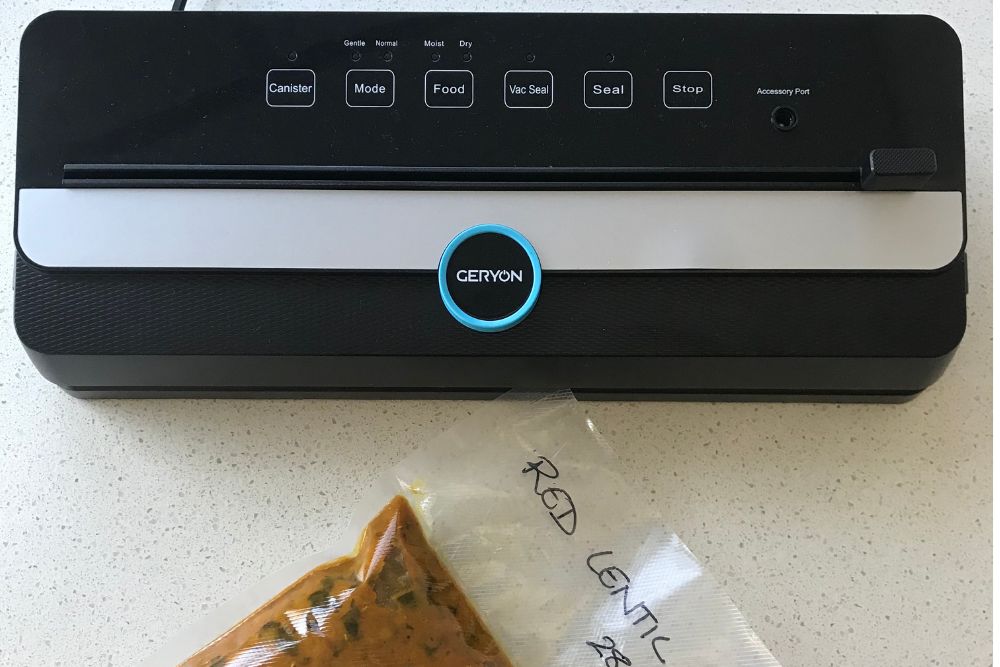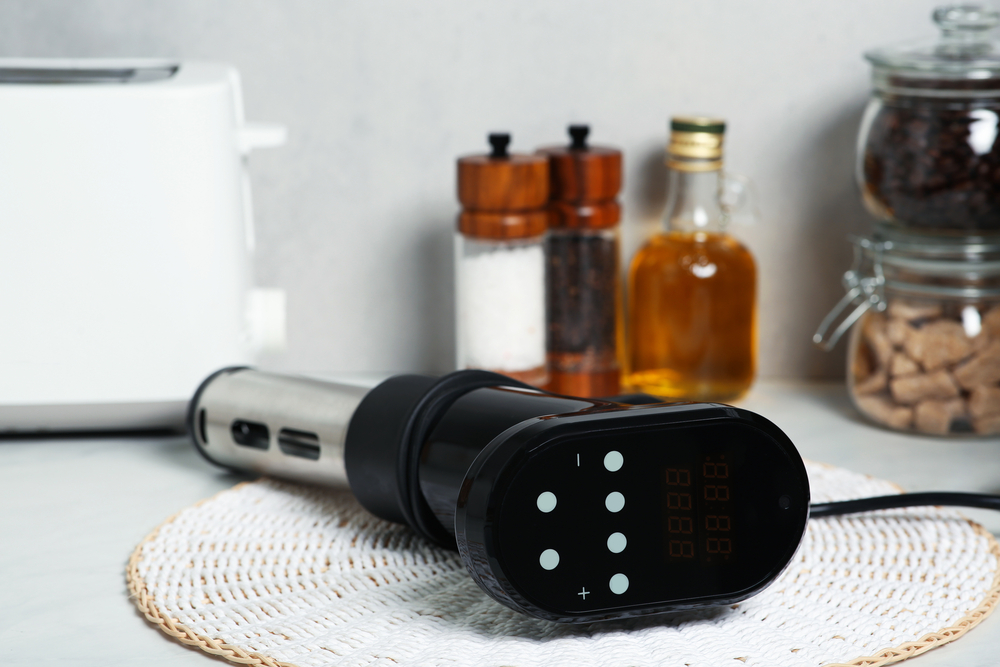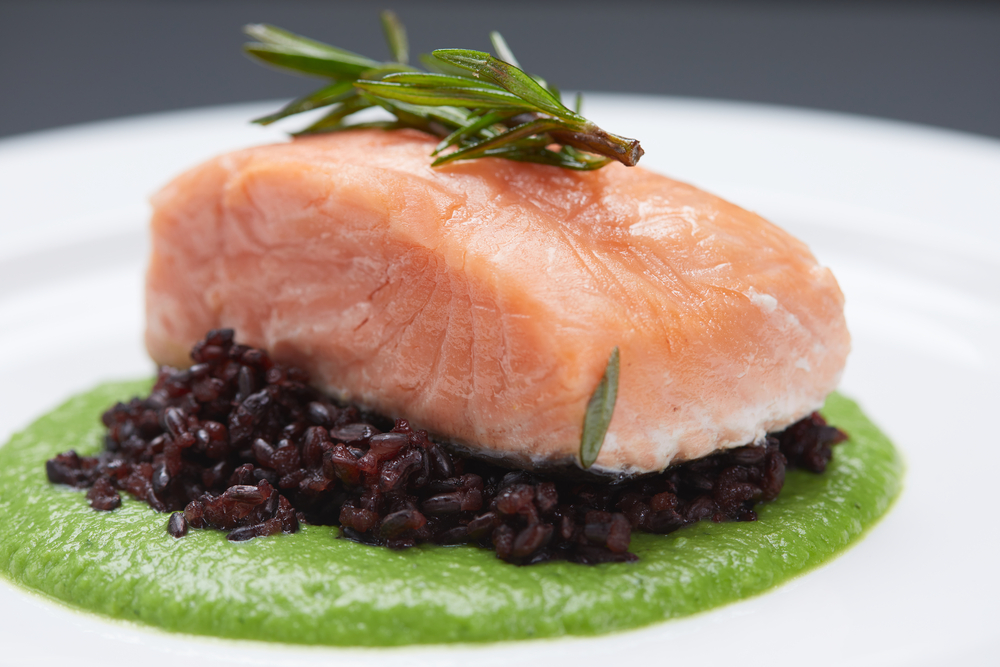Have you noticed how sous vide cooking has swept the culinary world in the last decade?
Are you wondering what all the fuss is about?
Well, the term sous vide is French for “under vacuum“, and that is precisely what the sous vide cooking process involves.
To explain this more fully, food of all types – from a steak to carrots in herb butter – is typically vacuum sealed into plastic bags. It is then cooked in a water bath. However, this cooking happens at very precise temperatures and over longer periods than conventional cooking methods. It is a sous vide machine, or an immersion circulator, that allows you to control both the temperature or the water and the cooking time so accurately.

The lack of oxygen in the bag, and scientifically selected cooking temperatures allow chefs to achieve results not possible using any other method. Numerous other benefits also come from using the technique.
In the mid 1960’s, the technique gained popularity in France and in recent years it has become one of the most popular methods used in commercial kitchens.
The reasons behind sous vide’s popularity are simple.
Benefits of Sous Vide Cooking:
Benefits For The Food
Food tastes fresher with more flavour locked in by the vacuum sealing process.
Fresh food colour is more vibrant and appealing, again due to the food not coming into direct contact with boiling water. After all, exposure to hot water leaches the colour from the food.
Food is cooked more evenly due to the low cooking temperatures involved. Sous vide recipes typically call for temperatures at which the food being cooked “breaks down” but no more. By doing this, no part of the food is ever over-cooked. When this is happening inside a vacuum sealed cooking bag, the food cannot dry out.
More vitamins and minerals are retained. This is due to the vacuum bags sealing in the nutrients and the low cooking temperatures not destroying them during the process.
For more information on Vacuum Sealers and Vacuum Sealer Bags and prices, click here.

Benefits For Caterers, Chefs and Commercial Kitchens
It’s a hugely reliable cooking process.
This means that kitchens can reproduce the same results time and again, making it an ideal solution in a commercial environment.
Why is this the case? Well, the low temperatures typical of sous vide cooking allow for a larger margin of error in cooking times. In a busy kitchen where time is precious, this allows chefs to concentrate on time-critical processes knowing that they can’t burn their whatever the immersion circulator is cooking.
For example, sauteeing a piece of fish on a grill top requires precise cooking times with constant attention. Just 2 minutes can mean the difference between perfection and disaster.
Due to the “set and forget” nature of sous vide cooking, it allows less experienced kitchen staff to manage the fish section. Therefore it provides a cost benefit to the running of the kitchen whilst allowing the experienced chefs to work on more critical stations.
Moreover, food can be prepared and cooked prior to service and refrigerated, then re-heated as required. This means faster service during busy periods. Faster service means more dishes served, happier customers and obviously greater revenues and improved business margins.
Another big bonus is that food shrinkage is reduced. How come? Well, sealing the produce into the cooking bag maintains its volume far better than conventional cooking methods. This translates into cost saving for the kitchen where they can purchase and serve smaller portions.
Sous vide proficiency is now a modern day must-have system for any professional kitchen or catering company. Commercial sous vide appliances are available at most price points for all kitchens, big or small.

You’ll find a step-by-step guide to the sous vide cooking process below:
The Sous Vide Process
The most popular sous vide cooking method is generally as follows :
1. Fill The Bag
The food to be cooked, plus any marinades, herbs and spices are placed in sous vide vacuum bags allowing room for the bag to seal. *Note: Bags must be designed for sous vide/re-heating and rated to withstand the cooking temperatures.
2. Vacuuming
The sous vide bags are evacuated and sealed using a vacuum sealing machine. The bags may be refrigerated to allow flavours to infuse at this point.
3. Cooking
The sous vide bags are placed into the sous vide cooking bath which has been set at the desired temperature as per the recipe. The water temperature should be allowed to stabilise before the bags are added. Bags are left to cook as the recipe dictates.
NB: A sous vide cooking bath can be a specialised piece of kitchen equipment or something quite simple. For example, you can use a regular saucepan with a sous vide machine (immersion circulator) dipped into it and get great results. In contrast, you can buy a purpose-made container and matching appliance.
4. Serve Or Cool
Once cooking is complete, food may be served immediately or taken for further finishing such as searing or baking depending on the recipe.
NB Food that is not to be served immediately should be cooled quickly and then refrigerated to avoid bacterial growth. This is often performed with a blast chiller or iced water.

5. Refrigerate
Bags may be refrigerated, but not frozen.
6. Re-Heat
Refrigerated bags may be brought up to temperature again by placing them back in the sous vide cooking bath at the cooking temperature prior to service.
7. Final Processing
Food may be removed from the vacuum sealed bags at this point and often seared or grilled quickly to caramelise the surface or improve the appearance of the finished product. Food is served at this point.
If you like red meat, sous vide steak is a thing of beauty. For the Best Steaks in Sydney, see here.
Sous Vide Food Safety
We strongly recommend the use of a calibrated independent digital food thermometer to test food temperatures inside the cooking bags to ensure that food is safe for consumption.
You should be aware that a registered Food Safety Plan must be in place for your kitchen to use sous vide in Australia. Contact your local food safety authority for more information. An excellent resource has been published by the NSW Food Authority which discusses the precautions that need to be taken when cooking using the sous vide method.
Questions and Answers
| What is sous vide cooking? | Sous vide cooking is a cooking method in which food is placed in a vacuum-sealed bag and then placed in a temperature-controlled water bath for a longer period of time than traditional cooking methods. The result is evenly cooked food with improved flavor and texture. |
| What are the key characteristics of sous vide cooking? | Precision temperature control; Long, slow cooking times; Vacuum-sealed bags preserve flavors and nutrients; An even cooking results in consistent texture and flavor; Can be used for a wide range of ingredients and dishes. |
| What are the benefits of sous vide cooking? | Improved flavor and texture; Consistent cooking results; Versatile cooking method; Efficient use of time and energy; Improved food safety |
| What are the pros of sous vide cooking? | Consistent and precise cooking results; Can cook large cuts of meat to perfection; Improves food safety; Can be done in advance, freeing up time for other tasks; Food retains nutrients and flavours |
| What are the cons of sous vide cooking? | Can be more expensive than traditional cooking methods; Requires specialized equipment (sous vide machine and vacuum sealer); Long cooking times can be inconvenient; Can be difficult to achieve a crispy or caramelized exterior; The food can sometimes present as pale and uninteresting without consideration given to plating aesthetics. |
RELATED:
The Best Steak Restaurants in Melbourne
The Best Steak Houses in Perth
Meatmaiden Steakhouse – Melbourne CBD
The Best Steaks and Steakhouses in Adelaide
The Best Steak Houses in Brisbane
- Orange Cake - April 23, 2024
- Best Cake Shops, Cake Delivery and Takeaway Cakes in Melbourne - April 23, 2024
- The 15 Best Mexican Restaurants In Melbourne - April 23, 2024
